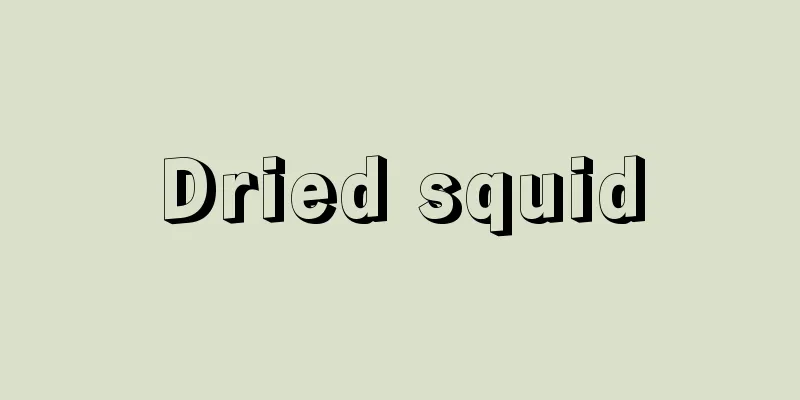Dried squid

|
Dried squid. Swordtip squid, spear squid, Bigfin reef squid, Mongo squid, and Japanese flying squid are used, but the majority of production is made up of Japanese flying squid. Depending on the type of squid used, they are divided into Ichiban Surume, Niban Surume, Koutsuki Surume, and Fukuro Surume, but they also have various other names depending on the manufacturing method and region. Ichiban Surume is made using Swordtip squid, and the highest quality ones are called Ichiban Migaki Surume, and those from Goto, Nagasaki Prefecture are famous. These names were given to indicate the grade of dried squid when it was exported to China during the Edo period, and at the time the best ones were called Migaki Jojoban. The old names are still used today. [Kaneda Hisashi] Manufacturing methodFirst-grade dried squid is made by splitting the abdomen of a large, fresh swordtip squid, removing the innards, eyes, and fins, washing the squid with water, then peeling off about 80% of the skin and drying it in the sun. The semi-dried squid is then placed in a drying room until it is 80% dry, rolled over a roller to stretch it, shape it, and then dry it in the sun again. Small swordtip squid are dried in the sun without removing the fins or skin. Second-grade dried squid is made by splitting the body of the Japanese flying squid, removing the innards and eyes, washing the squid with water, and hanging it on a rope or bamboo pole with the beak still attached to dry in the sun. After drying, it is covered with straw and becomes covered with a white powder. Second-grade dried squid is of inferior quality to first-grade dried squid. It is produced in large quantities in Hokkaido, Sanriku, Shimane, and other areas. Shell-finned dried squid is made from cuttlefish with shells. It is produced in the Chugoku and Shikoku regions. For dried squid, only the body parts of bigfin reef squid and Mizuika are used, and the body is left uncut and turned inside out before drying. It is made in Kyushu. [Kaneda Hisashi] Ingredients and UsesThe white powder on the surface is mainly the precipitate of taurine, a sulfur-containing amino acid. Dried squid has good quality protein, but because it is hard, it is harder to digest than raw squid. It can be grilled as is, soaked in water and marinated in soy sauce with herring roe, deep-fried, or made into shredded squid, shredded squid, or cut into squid bottles. [Kaneda Hisashi] Dried squid is called "Ichiban Dried Surume" ©Shogakukan The best dried squid The squid used in the making of this is called "Niban Surume" (second-stage squid ). Second dried squid Pour in hot sake and enjoy the aroma of the squid transferring to the sake. After using it as a sake bottle, grill it and eat it. You can enjoy the umami of the squid and the flavor of the sake that has soaked into it. ©Shogakukan "> Squid Sake Bottle Source: Shogakukan Encyclopedia Nipponica About Encyclopedia Nipponica Information | Legend |
|
イカの素干し。ケンサキイカ、ヤリイカ、アオリイカ、モンゴウイカ、スルメイカなどを用いるが、生産量の大部分はスルメイカで占められる。原料イカの種類により一番するめ、二番するめ、甲付(こうつき)するめ、袋するめなどに分けられるが、このほかそれぞれの製法や土地によりいろいろの名がつけられている。一番するめはケンサキイカを用いてつくるが、とくに上等のものは一番磨(みがき)するめとよび、長崎県五島産のものが名高い。こうした名称は江戸時代、するめを中国へ輸出する際に等級を示すためにつけたもので、当時、最高のものは磨(みが)き上々番(じょうじょうばん)といわれた。現在も昔の呼び名がそのまま使われている。 [金田尚志] 製法一番磨するめは、新鮮で大形のケンサキイカの腹を裂き、内臓、眼球、ひれをとり、水洗(すいせん)後、外皮を八分どおり剥(は)ぎ、日干しする。半乾きとなったものを乾燥室に入れて八分乾きとし、ローラーを転がして伸ばし、形を整えたのち、さらに日干しする。小形のケンサキイカはひれや皮を除かずそのまま日干しする。二番するめはスルメイカの胴を裂き、内臓、眼球を除き水洗後、くちばしはつけたままで縄や竹竿(たけざお)などにかけて日干しする。乾燥後、藁(わら)で覆うと白い粉がふく。二番するめは一番するめに比べて品質が劣る。北海道、三陸、島根などで多くつくられる。甲付するめは甲をもったコウイカ類からつくる。中国、四国地方が産地。袋するめはアオリイカ、ミズイカの胴部のみを用い、胴は切らずに裏返して乾燥する。九州でつくられる。 [金田尚志] 成分と利用表面の白い粉は主として含硫アミノ酸のタウリンが析出したもの。するめのタンパク質は良質だが、硬いのでなまのものに比べ消化されにくい。そのまま焼いたり、水にもどし数の子といっしょにしょうゆに漬けたり、油で揚げるほか、裂きいか、のしいか、刻みするめにしたり、いか徳利をつくる。 [金田尚志] ケンサキイカを原料とするするめを「一番するめ」という©Shogakukan"> 一番するめ スルメイカを原料とするめを「二番するめ」という©Shogakukan"> 二番するめ 燗酒を入れて、イカの香りを酒に移して楽しむ。徳利として使用したあとはあぶって食べる。するめのうま味と、しみ込んだ日本酒の風味が味わえる©Shogakukan"> いか徳利 出典 小学館 日本大百科全書(ニッポニカ)日本大百科全書(ニッポニカ)について 情報 | 凡例 |
<<: Japanese common squid (Japanese common squid)
>>: Sulfonic acid - suruhonsan (English spelling) sulfonic acid
Recommend
Podium
…Some people believe that the arch, which played ...
Loriculus
…A general term for birds in the genus Loriculus ...
Horror stories - kaikishosetsu
It is also called horror fiction or supernatural ...
Aucassin and Nicolette - Aucassin and Nicolette (English spelling)
A medieval French song story. Author unknown. Dat...
Tatsugo [town] - Tatsugo
A town in Oshima District, northeast of Amami Oshi...
Uematsu Arinobu
Year of death: 20th June 1910 (17th July 1813) Yea...
Takuan pickles - Takuan pickles
〘Noun〙 A type of pickle. Miyaju daikon or its desc...
Silvestri, C. (English spelling)
...Many of his works are based on folk songs, and...
Rice Year - Inadashi
…The Bontoc Igorot people of the Philippines, who...
Innovation (English spelling)
A central concept in J.A. Schumpeter's theory ...
LET - LET
It is an abbreviation for linear energy transfer, ...
Sodium Hypochlorite - Sodium Dibenzoate
The common name accepted by IUPAC for NaOCl (74.4...
Alamogordo - Alamogordo (English spelling)
A commercial city in southern New Mexico, United ...
Bryophyte Coral
Also known as coral moss or tamarisk. A perennial ...
Waldorf - Waldorf
…American saloons, which were bars licensed to se...









